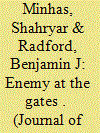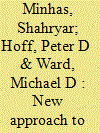| Srl | Item |
| 1 |
ID:
156536


|
|
|
|
|
| Summary/Abstract |
There has been much disagreement about the relationship between civil wars and state economic performance. While civil war is often associated with poor economic performance, some states have managed robust growth despite periods of domestic armed conflict. We find this disagreement results from not accounting for the spatial distribution of conflict within a country. A robust literature in economics stresses the role major cities play in economic growth. We hypothesize that the economic impact of civil conflict is contingent on the conflict’s location relative to major urban centers within a state. We use subnational data on the location of conflict relative to urban areas to test the impact of domestic conflict on annual gross domestic product growth. In doing so, we bridge the economic development literature on the importance of cities with extant literature on the effect of armed conflict to provide a novel explanation for the paradox of high macroeconomic growth in conflict-ridden countries.
|
|
|
|
|
|
|
|
|
|
|
|
|
|
|
|
| 2 |
ID:
153656


|
|
|
|
|
| Summary/Abstract |
While some borders are real firewalls against conflicts, others appear like tinder just waiting for the smallest spark. Only recently has research focused on the transnational perspective of conflict and current research has focused mostly on isolated aspects of this phenomenon. In this article, we provide a unified framework for conflict contagion that takes into account receiver, sender, dyad, and network effects. This is a novel perspective on conflict contagion, and our empirical results suggest that distinguishing between sender and receiver effects allows for a better understanding of spillover effects. We provide insights that especially excluded ethnic groups impact the risk of countries sending and receiving conflicts from its neighbors.
|
|
|
|
|
|
|
|
|
|
|
|
|
|
|
|
| 3 |
ID:
145703


|
|
|
|
|
| Summary/Abstract |
Previous models of international conflict have suffered two shortfalls. They tend not to embody dynamic changes, focusing rather on static slices of behavior over time across a single relational dimension. These models have also been empirically evaluated in ways that assumed the independence of each country, when in reality they are searching for the interdependence among all countries. A number of approaches are available now for analyzing relational data such as international conflict in a network context and a number of these can even handle longitudinal relational data, but none are developed to the point of exploring how networks can coevolve over time. We illustrate a solution to the limitations of existing approaches and apply this novel, dynamic, network based approach to study the dependencies among the ebb and flow of daily international interactions using a newly developed, and openly available, database of events among nations.
|
|
|
|
|
|
|
|
|
|
|
|
|
|
|
|